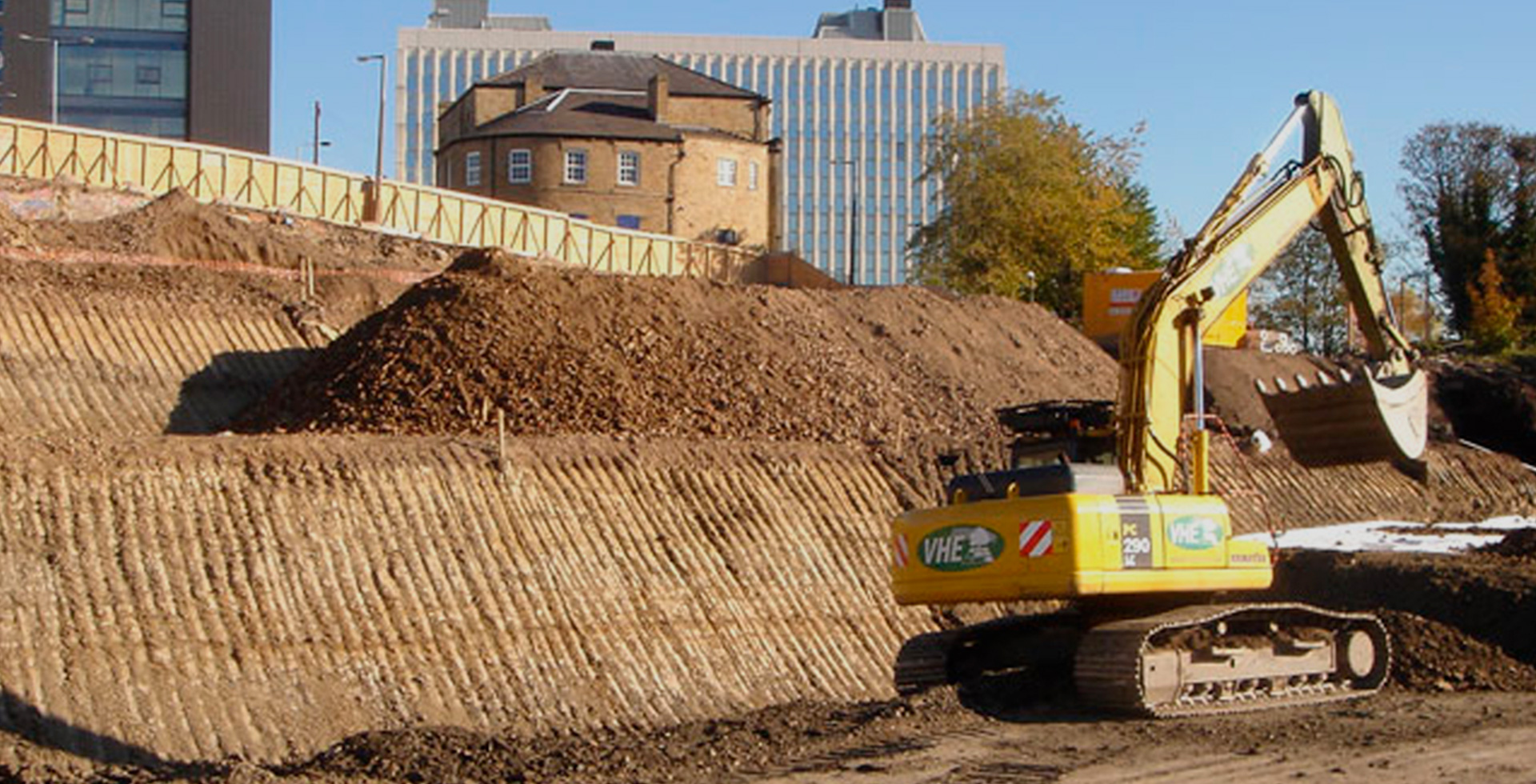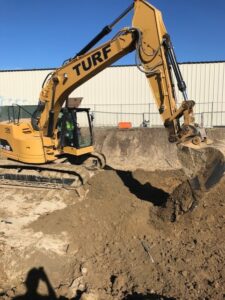
Slope failure, a geologic phenomenon involving the downward movement of rock, soil, and debris, can have severe consequences for natural landscapes, infrastructure, and communities. To effectively address this issue, it is crucial to comprehend the various factors that contribute to slope failure. In this in-depth guide, brought to you by G3SoilWorks, we will delve into the intricacies of slope failure causes, spanning geological factors, weather conditions, human activities, climate change, slope failure examples and more.
The geology of an area plays a pivotal role in slope stability. Rocks and soils with low cohesion, such as loose sedimentary materials, are more susceptible to failure. Conversely, well-consolidated rocks and cohesive soils offer greater resistance.
Water infiltration, whether from rainfall, groundwater, or surface runoff, can significantly impact slope stability. Saturated soil loses strength and cohesion, making it prone to failure. Water acts as a lubricant, facilitating the movement of materials downslope.
Geological features, such as fault lines, joints, and steep rock formations, can weaken slopes. These structures create zones of weakness where stress concentrates, increasing the likelihood of failure.
Prolonged or intense rainfall can lead to the saturation of slopes, increasing their weight and reducing stability. This often triggers landslides, mudflows, or debris flows.
Seismic activity, prevalent in certain regions, can trigger slope failures. Ground shaking during an earthquake can destabilize slopes, leading to landslides or rockfalls.
Landslides can be both a consequence and a cause of slope failure. Factors like excessive rainfall, geological conditions, and human activities can contribute to landslides, further exacerbating slope instability.

Altering natural terrain through excavation or construction can disrupt the equilibrium of slopes. Removing or adding material, changing slope angles, and improper compaction can all contribute to slope failure.
Trees and vegetation play a vital role in stabilizing slopes by binding soil together with their root systems. Deforestation and land clearance reduce this stabilizing effect, making slopes more vulnerable.
Inadequate drainage or poorly designed drainage systems can lead to water accumulation on slopes. This can saturate the soil and reduce its stability, increasing the risk of failure.
Climate change is ushering in a new era of weather extremes, with one significant impact being the intensification of rainfall events. Rising global temperatures lead to increased evaporation rates, loading the atmosphere with moisture. Consequently, when rain does fall, it tends to do so with greater intensity and in shorter durations. This heightened rainfall intensity poses a severe threat to slope stability. Soils become saturated more rapidly, losing their ability to hold together. In hilly or mountainous regions, the risk of landslides surges as the excess water infiltrates the ground, increasing its weight. The culmination of these factors can overwhelm slopes, triggering landslides and jeopardizing both human settlements and ecosystems.
In colder regions, climate change manifests in the form of rising temperatures, causing permafrost to thaw. Permafrost, frozen soil or rock that remains at or below freezing temperatures for two or more years, provides a natural stabilizing foundation for slopes. However, as temperatures rise, permafrost begins to melt, leading to soil liquefaction and slope destabilization. What was once a rock-solid anchor can transition into a slurry of mud and water, rendering slopes susceptible to failure. This thawing process poses substantial risks to infrastructure and ecosystems in regions reliant on permafrost stability.
Coastal areas, including Costa Mesa, are acutely vulnerable to the effects of climate change, particularly sea level rise and coastal erosion. As global temperatures increase, polar ice caps melt, leading to rising sea levels. Consequently, the shoreline creeps inland, encroaching upon coastal slopes. This dynamic interaction between sea and land can trigger slope instability. The erosion of shoreline slopes, which were once stable, accelerates as sea levels rise and waves intensify. Eventually, this can lead to the retreat and collapse of coastal slopes, posing a threat to coastal communities and infrastructure. The need for comprehensive strategies to manage coastal erosion and safeguard against slope instability becomes increasingly critical in such areas.
Examining past slope failure incidents worldwide provides valuable lessons. Events like the Oso landslide in Washington State serve as cautionary tales and underline the importance of proactive mitigation measures.
Creep slope failure, a slow and gradual form of slope movement, can go unnoticed until it reaches a critical point. Understanding the signs and mechanisms of creep slope failure is essential for early detection and mitigation.
In the realm of slope stabilization, a range of methods is available to bolster slope integrity. Retaining walls, for instance, are structures built to hold back soil and prevent downslope movement. These walls are engineered to distribute pressure and maintain slope stability effectively. Soil nailing is another technique wherein reinforcing elements, like rods or bars, are inserted into the slope and anchored to provide structural support. Additionally, vegetation restoration involves planting native species with deep root systems that bind soil together, reducing erosion and enhancing slope stability. Employing these techniques can significantly reduce the risk of slope failure, ensuring long-term safety and resilience.
Implementing monitoring systems is pivotal for the proactive management of slope stability. Instruments such as inclinometers and ground sensors continuously track the subtle movements and changes within a slope. By detecting even minor shifts in slope conditions, these systems provide early warnings of potential instability. Timely intervention can then be initiated, potentially preventing catastrophic events like landslides. Monitoring and early warning systems are indispensable tools in safeguarding communities, infrastructure, and natural environments against the devastating consequences of slope failure.
Effective land use planning and stringent regulations play a vital role in mitigating the risks associated with slope instability. Comprehensive zoning ordinances can designate high-risk areas as unsuitable for construction or development, preserving them as green spaces or natural buffers. By enforcing strict building codes and permitting procedures, authorities can ensure that construction in vulnerable zones adheres to safety guidelines. These measures not only protect lives and property but also safeguard the environment by preventing further degradation of already unstable slopes. Thoughtful land use planning and robust regulations are essential pillars in minimizing the impact of slope failure on communities and ecosystems.

After having learnt more about slope failure and slope failure examples, let us know understand how we are G3SoilWorks can help you.
G3SoilWorks has some of the most experienced geologic engineers in Southern California. Our principals are veterans, with over 100 years in geotechnical, environmental, and engineering geologic consulting experience throughout the southwest and western United States.
G3SoilWorks, a leader in slope stability solutions, is dedicated to helping communities in Costa Mesa, CA, and beyond mitigate the risks associated with slope failure. With our expertise, we provide tailored strategies and solutions to ensure the safety of your community, infrastructure, and environment. Contact us today to safeguard your future against the challenges of slope failure. Call us at +1 714-668-5600 for more information.
A. Slope failure is a geological phenomenon where rocks, soil, or debris move downslope, posing risks to landscapes and human infrastructure. Understanding its causes is crucial for assessing and mitigating these risks, ensuring the safety of communities and the environment.
A. Climate change intensifies rainfall, causing rapid soil saturation and triggering landslides. In cold regions, rising temperatures lead to permafrost thaw, destabilizing previously stable slopes. Additionally, sea-level rise and coastal erosion can erode shoreline slopes, increasing the risk of failure.
A. G3SoilWorks offers a range of slope stabilization techniques, including retaining walls, soil nailing, and vegetation restoration. Our experts also provide monitoring and early warning systems, ensuring timely intervention. Moreover, we emphasize responsible land use planning and regulations to prevent construction in high-risk areas, promoting safety and sustainability.
Follow, engage, learn. Stop by our blog to see what’s happening at G3SoilWorks.
G3Soilworks – a full service geotechnical/ engineering geologic consulting firm serving clients since 2009 and delivering expert solutions with our highly experienced team and specialized consultants.
G3SoilWorks
350 Fischer Avenue Costa Mesa, CA 92626
Tel. 714.668.5600
E. info@g3soilworks.com